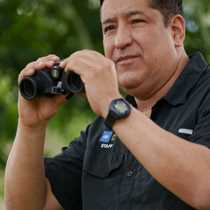Isabela Island
Isabela Island, the largest island in the Galápagos Archipelago, gave to us immense satisfactions today. Several options were offered, as usual with Lindblad Expeditions, depending on the different interests our guests have, the most demanding expectations were met. To give you an idea, I will briefly list several of the activities we enjoyed today. Some guests opted to do a long but beautiful and successful hike to the rim of Sierra Negra volcano and then on to the site of the most recent volcanic activity on the volcano, Volcan Chico. Others that remained in the picturesque town of “Puerto Villamil” and its surroundings had a lot to do, including a visit to the historical site of the “Muro de las Lagrimas,” Spanish for “The Wall of Tears;” a swim from a beautiful white sandy beach, or a snorkel within a protected local bay to name just some of the activities. Some guests walked on an incredible young lava flow, or on a boardwalk crossing marshes and mangrove areas. We even had time to pay a short visit to a local cemetery, ate and drink local coconuts, and walked inside a recent lava tube.
All of us anyway, at different times, had the extraordinary opportunity to visit the Isabela Island branch of the world famous “Charles Darwin Research Station” (CDRS). In this place the Galápagos National Park in conjunction with the CDRS are involved in the restoration of several endangered tortoise subspecies that inhabit southern Isabela Island. One of these rare subspecies, often referred as races, is the one shown in the picture of today. For me, this is one of the most intriguing and fascinating tortoise subspecies of the Galápagos. The whole wild population of the “flat-shell backs” (or in Spanish “Los Aplastados”) consisted in only 70 individuals. This peculiarly shaped giant tortoise race inhabits an area known locally as “Cinco Cerros.” This area is found near the huge “Cerro Azul” volcano. As recently as 1998, Cerro Azul volcano erupted and consequently the rare tortoises were endangered. Some individuals were unfortunately severely burned. Several others were rescued by helicopter and since then they have been living in the CDRS. The reproduction, incubation, rearing and repatriation programs with this race have been a great success. To date, approximately 500 “flat-shell back” giant tortoises have hatched in the CDRS and many of them have been reintroduced successfully to their native habitat. This story, with all its conservation connotations, is truly amazing and is a good example of the titanic efforts made in order to save these fantastic critters.
Isabela Island, the largest island in the Galápagos Archipelago, gave to us immense satisfactions today. Several options were offered, as usual with Lindblad Expeditions, depending on the different interests our guests have, the most demanding expectations were met. To give you an idea, I will briefly list several of the activities we enjoyed today. Some guests opted to do a long but beautiful and successful hike to the rim of Sierra Negra volcano and then on to the site of the most recent volcanic activity on the volcano, Volcan Chico. Others that remained in the picturesque town of “Puerto Villamil” and its surroundings had a lot to do, including a visit to the historical site of the “Muro de las Lagrimas,” Spanish for “The Wall of Tears;” a swim from a beautiful white sandy beach, or a snorkel within a protected local bay to name just some of the activities. Some guests walked on an incredible young lava flow, or on a boardwalk crossing marshes and mangrove areas. We even had time to pay a short visit to a local cemetery, ate and drink local coconuts, and walked inside a recent lava tube.
All of us anyway, at different times, had the extraordinary opportunity to visit the Isabela Island branch of the world famous “Charles Darwin Research Station” (CDRS). In this place the Galápagos National Park in conjunction with the CDRS are involved in the restoration of several endangered tortoise subspecies that inhabit southern Isabela Island. One of these rare subspecies, often referred as races, is the one shown in the picture of today. For me, this is one of the most intriguing and fascinating tortoise subspecies of the Galápagos. The whole wild population of the “flat-shell backs” (or in Spanish “Los Aplastados”) consisted in only 70 individuals. This peculiarly shaped giant tortoise race inhabits an area known locally as “Cinco Cerros.” This area is found near the huge “Cerro Azul” volcano. As recently as 1998, Cerro Azul volcano erupted and consequently the rare tortoises were endangered. Some individuals were unfortunately severely burned. Several others were rescued by helicopter and since then they have been living in the CDRS. The reproduction, incubation, rearing and repatriation programs with this race have been a great success. To date, approximately 500 “flat-shell back” giant tortoises have hatched in the CDRS and many of them have been reintroduced successfully to their native habitat. This story, with all its conservation connotations, is truly amazing and is a good example of the titanic efforts made in order to save these fantastic critters.




